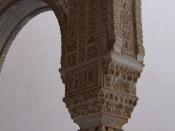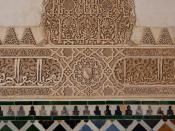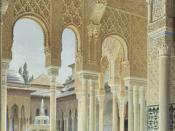The Alhambra
(the red one)
Granada, Spain, 1238-1358
The Alhambra (the red one), is a palatine city of the Nasrid sultans. It is not only one of the most celebrated of the monuments created under their patronage, but also one of the most renowned works of world architecture. Palaces of the Alhambra are famous for the interplay of the architecture within its landscape, exemplified in its views framed by its many pavilions and towers, as well as by its famous interior courtyards.
Founded by the first Nasrid sultan, Muhammad I, who came to power in 1232, the complex underwent frequent additions and changes during the thirteenth and fourteenth centuries. Its walls enclosed a fortress, baths, mosques, industries, and a number of palaces and gardens.
The existing palaces are the Partal Palace, built during the reign of Muhammad III, the Palace of the Myrtles, built during the reigns of Isma'il I, Yusuf I, and Muhammad V, and the Palace of the Lions, built during the reign of Muhammad V.
Each of these palaces were named by people other than their architects or builders and have no relation to their original names.
The walls of the Alhambra stand out against the Sierra Nevada. The palace is essentially a fortified citadel built upon an 11th century castle. This exterior part of the Alhambra is titled the Alcazaba.
Within the Alcazaba's walls, occupants of more than one religion can be identified as their ideas and beliefs are shown through various architectural designs and symbols. The reason there are a number of religions to be recognized is because through history various groups took control of the Alhambra. The Alhambra was born into and is principally characterized by Islamic faith and architects, but in 1492 it became a Christian court when the catholic monarchs conquered...


